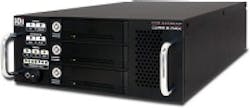Intelhas made a number of recent announcements that further solidify the notion that the California-based company is fully committed to bringing autonomous vehicles to public roads, and soon.
First, the company announced a new brand called Intel GO, which is specifically tailored for the autonomous driving market. New with the Intel GO brand are multiple development kits that scale in performance from the Intel Atom to the Intel Xeon processor, as well as what is reportedly the industry’s first 5G-ready development platform for automated driving. The Intel GO In-Vehicle Development Platforms for Automated driving also feature Arria 10 FPGAs, and multiple I/O, including GigE, 100BASE-T1, CAN FD, FlexRay, USB 2.0, USB 3.0, and UART. Additionally, the among other features, the platform features a software development kit, including SDKs for deep learning, computer vision, OpenCL, and sensor data labeling.
"The introduction of our Intel GO system extends the invaluable investment we have made in the automotive sector for years," said Doug Davis, senior vice president and general manager of the Automated Driving Group at Intel. "Our rich automotive heritage includes 49 car wins with more than 30 Intel-based vehicle models on the road today. What’s probably not as well-known is the fact that Intel is in hundreds of autonomous test cars on the road today."
He continued, "Industry leaders like BMW, Delphi and Baidu have all announced plans to use Intel technology in their autonomous vehicles. In fact, BMW together with Intel and Mobileye announced today that a fleet of approximately 40 autonomous BMW cars – with Intel GO solutions inside – will be on the road by the end of 2017."
As we previously noted,BMW Group, Intel, and Mobileye announced plans to bring autonomous vehicles into series production by 2021. Now, the companies announced that they will have around 40 autonomous test vehicles on the roads by the second half of 2017. This news was announced at CES 2017 in Las Vegas, where the companies explained that the BMW 7 series will employ Intel and Mobileye technologies during global trials starting in the U.S. and Europe.
"Making autonomous driving a reality for our customers is the shared ambition behind our cooperation with Intel and Mobileye," said Klaus Fröhlich, Member of the Board of Management of BMW AG for Development. "This partnership has all of the skills and talent necessary to overcome the enormous technological challenges ahead and commercialize self-driving vehicles."
"Therefore," he continued, "we are already thinking in terms of scalability and welcome other companies – manufacturers, suppliers or technology companies – to participate and contribute to our autonomous platform. This year our fleet of vehicles will already test this joint technology globally under real traffic conditions. This is a significant step towards the introduction of the BMW iNEXT in 2021, which will be the BMW Group’s first fully autonomous vehicle."
Lastly, Intel announced that it will acquire a 15% stake in HERE, a global provider of digital maps and location-based services, from HERE’s current indirect shareholders: AUDI, BMW, and Daimler. In conjunction with the acquisition of a stake in HERE, the two companies also signed an agreement to collaborate on the research and development of "a highly scalable proof-of-concept architecture that supports real-time updates of high-definition maps for highly and fully automated driving."
Pictured: BMW engineer, André Mueller, tests autonomous driving technology in a BMW autonomous test car.
View more information on Intel.
Share your vision-related news by contacting James Carroll, Senior Web Editor, Vision Systems Design
To receive news like this in your inbox, click here.
Join our LinkedIn group | Like us on Facebook | Follow us on Twitter
Learn more: search the Vision Systems Design Buyer's Guide for companies, new products, press releases, and videos
About the Author

James Carroll
Former VSD Editor James Carroll joined the team 2013. Carroll covered machine vision and imaging from numerous angles, including application stories, industry news, market updates, and new products. In addition to writing and editing articles, Carroll managed the Innovators Awards program and webcasts.
